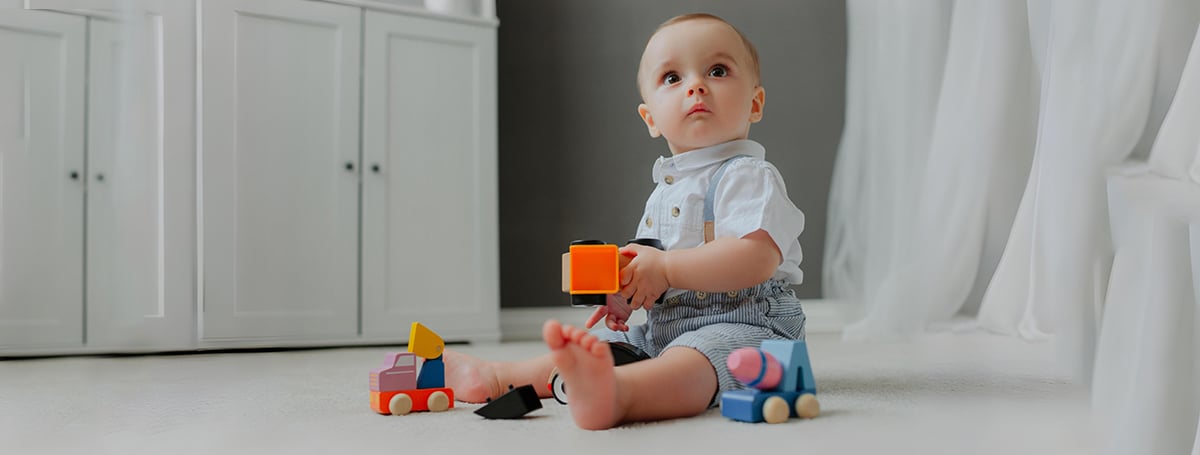6-Month Baby Milestones: What to Expect and How to Support Your Baby’s Development?
6 Month Baby Development: Growth & Milestones
Wasn’t it just yesterday that you held your tiny newborn in your arms? And now, here they are—already six months old, full of curiosity, giggles, and newfound skills. This stage is a beautiful mix of excitement and questions—what kind of developments to expect at 6 months? Are they growing as they should? Should they be sitting up, babbling more, or reaching for things?
While every baby grows at their own pace, knowing the key 6 month milestones can help you cherish their progress with confidence. So, let’s explore the wonderful changes your little one might be experiencing at six months.
6 Month Baby Milestones: Growth
When it comes to baby development at 6 months, your little one’s growth continues, but the rapid weight gain of the newborn phase starts to slow down. This is completely natural as they become more active and burn more energy. On average, a 6-month-old baby boy weighs around 7.90 kg and measures about 26.5 inches in length, while a 6-month-old baby girl typically weighs 7.30 kg and is about 26 inches long. However, every baby grows at their own pace, and slight variations are completely normal. If you’re concerned about your little one’s development, consulting their paediatrician can help ensure they are on track.
6 Month Old Milestones: Motor Skills and Physical Development
At six months, your baby is gaining strength and control over their movements. Here are the key 6 month old baby milestones related to physical development and motor skills:
- Rolling Over with Ease Your baby has likely mastered rolling from their tummy to back and is now rolling in both directions. This means they can shift positions independently, making diaper changes a bit more challenging.
As babies become more mobile, they might roll unexpectedly. To prevent falls and injuries, you must keep one hand on them at all times, especially when they’re on the bed or couch. Multi-tasking is also not advisable as you’ll need to be attentive to your baby’s every move at this stage.
- Sitting with (or Without) Support: At this stage, babies start sitting upright. Initially, they lean on their hands for balance, but with time, they develop stronger core muscles and can sit unsupported. Many can now sit steadily in a high chair, which is great for mealtime.
- Leg Strength and Bouncing Fun: Your little one is getting stronger. When held upright, they push down on their legs against a firm surface and may even start bouncing up and down. Many babies love this movement and enjoy time in a baby bouncer. Some babies may also try to push themselves into a standing position when supported, showing early signs of standing with assistance.
- Rocking in Preparation for Crawling: Some babies begin rocking back and forth on all fours, preparing for crawling. While a few may start crawling at this age, most will take a few more months before they start moving independently.
- Improved Hand Coordination: Your baby’s hand skills are becoming more refined. They can now grab objects and bring them closer, pass items from one hand to another, and even let go of objects intentionally. For more details on these milestones, explore our comprehensive guide.
Our Products
6 Month Milestones: Cognitive and Sensory Development
At six months, your baby’s brain is growing rapidly, and their cognitive development is accelerating as they become more curious about the world around them. Here are the key 6 month old baby milestones related to cognitive and sensory development:
- Exploring Through the Mouth Your baby is in full exploration mode, and their favorite way to learn is by putting an object in their mouth. This helps them understand textures, shapes, and even tastes.
- Showing Preferences and Making Choices: By six months, babies begin expressing likes and dislikes. If they don’t want more food, they may close their lips tightly. Similarly, they reach for toys they want and ignore the ones they aren’t interested in. For example, your baby might choose between two toys or foods by reaching for one and pushing the other away.
- Recognising Familiar Faces: Your baby can now differentiate between familiar people and strangers. They may react with excitement when they see a parent or caregiver and show hesitation or wariness around unfamiliar faces.
- Recognising Their Name At six months, many babies start responding to their name. If you call them, they may turn their head or smile, showing early language recognition.
- Increased Curiosity About Their Surroundings: Your baby will spend a lot of time observing their environment, watching objects move, and reaching for things just beyond their grasp. This curiosity drives learning, so providing colourful, textured toys and safe household objects can keep them engaged. Babies at this age may also search for partly hidden objects, which is an important sign of their growing cognitive development.
6 Month Old Milestones: Social and Emotional Development
At six months, babies are becoming more expressive and social, responding to the people and emotions around them. This is also a crucial time for language development, as babies begin to communicate and interact in new ways. Here are the key 6 month milestones related to social, emotional, and communication skills:
- Enjoying Mirror Time: Babies at this stage love looking at their reflection in mirrors. They may smile, laugh, or even try to interact with their “mirror friend,” which helps them develop self-awareness.
- Responding to Emotions: Your baby is becoming more in tune with emotions. They can sense when you’re happy, sad, or stressed and may react accordingly. If you smile, they may smile back; if you seem upset, they might fuss or cry in response. Babies also react to your facial expressions, learning to read and mimic them as part of their social and emotional growth.
- Expressing Happiness Through Laughter: Laughter becomes a regular part of their interactions. They giggle when tickled, react joyfully to playful sounds, and enjoy silly games like peek-a-boo.
- Taking Turns in Communication: Your baby is starting to engage in simple conversations! They enjoy taking turns making different sounds with you and may respond to your voice with babbling, squealing, or blowing raspberries.
- Early Speech Development: Your baby’s vocal skills are improving, and they are experimenting with different sounds. They may start ‘talking’ by babbling and repeating sounds like “baba” or “dada” and love it when you mimic their sounds, encouraging them to continue learning language.
- Playtime and Social Interaction: Playing is a key part of social development. Babies at this age love interactive games like pat-a-cake and peek-a-boo. These games help them learn about cause and effect, memory, and turn-taking.
Our Products
6 Month Baby Milestones: Nutrition and Feeding
While 6 month old baby milestones vary from child to child, this is generally the time when parents can begin introducing complementary foods alongside breast milk or formula. Not all babies are ready for solids right at six months, but some common indicators include:
If your baby hasn’t yet shown these signs, there’s no rush—every baby develops at their own pace.
Traditionally, parents started with iron-fortified infant cereals, but it’s not a necessity. Some great first foods include:
It’s common for babies to reject solid foods initially. If your little one turns away or refuses, don’t be discouraged. Keep offering the food in small amounts—sometimes it takes multiple tries before a baby accepts a new taste or texture.
Even with the introduction of solids, breast milk or formula remains the primary source of nutrition. A 6-month-old typically needs 790–900 grams of breast milk or formula daily, spread across five to six feedings. This ensures they get all the essential nutrients required for healthy growth. For breastfed babies, nursing isn’t just about nutrition—it also provides comfort. As they experience rapid growth and developmental changes, they may nurse more frequently for reassurance and bonding, which is completely normal.
6 Month Milestones: Sleep Patterns
By six months, many babies develop a more predictable sleep schedule, though sleep needs can vary. On average, a 6-month-old requires 12 to 16 hours of total sleep per day, including both nighttime sleep and naps. A typical pattern may involve about 10 hours of sleep at night and 4 hours spread across two to three daytime naps.
Most babies at this stage begin sleeping for longer stretches at night, and some may even sleep through the night. However, it is still normal for babies to wake up occasionally, sometimes for a feeding or due to changes in their sleep cycle. Some babies may also start resisting naps or bedtime because they are excited about exploring the world around them.
Around this age, some babies experience sleep regression, where they struggle to fall asleep or wake up more frequently. This can happen as they develop new skills and become more aware of their surroundings. If your baby’s sleep routine seems disrupted, maintaining a consistent bedtime routine and ensuring a soothing sleep environment can help.
Ensuring a dry and comfortable diaper is crucial for uninterrupted sleep, and Teddyy Baby Diapers can help with that. Designed for superior absorption and long-lasting dryness, Teddyy Diapers prevent leakage and discomfort, allowing babies to sleep peacefully through the night. The soft, breathable material provides maximum comfort, ensuring a soothing sleep environment that can help foster healthier sleep patterns.
Tracking Your Baby’s Progress at 6 Months
Reaching the six-month mark is truly an exciting time for both babies and parents. At this age, most babies are showing off new skills and along with a selection of developmental milestones that highlight just how much they’re growing. As your baby explores the world, you’ll notice them developing in unique ways—whether it’s through new sounds, playful movements, or curious glances at familiar people.
Tracking your baby’s progress during these early months is more than just a way to celebrate their achievements; it’s an important part of supporting their overall development. By keeping an eye on how your child is developing—whether it’s their ability to interact, respond to sounds, or explore their surroundings—you can spot any concerns early and ensure they’re getting the support they need.
Every child develops at their own pace, and it’s normal for some babies to reach certain milestones a little earlier or later than others. As a parent, your observations and interactions play a key role in your baby’s development. Take time to talk, play, and respond to your baby’s cues, and don’t hesitate to reach out to your pediatrician if you have any concerns about your child’s development. Remember, early intervention can make a big difference–you are your baby’s best advocate during this exciting stage of growth.
Conclusion
Your baby’s journey through their 6 month milestones is a beautiful mix of growth, discovery, and endless wonder. Every little giggle, every attempt to sit up, and even the occasional sleepless night is a step toward something amazing. As babies learn about their environment through daily experiences and interactions, each moment contributes to their development as they become more alert and mobile. While this phase comes with its share of challenges—fussy feedings, sleep regressions, and teething discomfort—remember that you’re doing an incredible job. Creating a nurturing environment, filled with love, comfort, and care, can make all the difference in supporting your child’s development. As your baby grows, you might also be interested in milestones at 9 months to see what exciting developments lie ahead.
Monitoring children’s development and learning the signs of typical progress is essential. Most children reach certain milestones by 6 months, but every child is unique and may progress at their own pace. If you notice lost skills or delays in your child’s development, act early by consulting your pediatrician. Early intervention can make a significant difference.
We hope we’ve given you all the information you need to monitor your baby’s development in the sixth month of their life. However, please do not use this article as a substitute for standardized, validated developmental screening tools–always seek professional advice for any concerns.
Faq's
1. What key milestones should a healthy 6-month-old baby typically reach?
Rolls both ways, sits with support (may sit briefly unaided), pushes up and bears weight on legs. Reaches and transfers objects, brings to mouth; babbles (“ba/da”), laughs, turns to sounds/name. Shows interest in solids (start iron-rich foods), enjoys peek-a-boo, prefers familiar people.
2. How can I support my baby’s development with everyday activities?
Why this matters: Parents love practical tips they can use right away.
Answer-backed by sources: Engage in tummy time to build strength, talk/read/sing to encourage language, mimic their sounds and expressions for social development, and introduce interactive games like peek-a-boo.
3. What feeding milestones and solid food readiness cues should I watch for?
Why this matters: Parents often wonder when and how to start solids.
Answer-backed by sources: Many six-month-olds are ready to begin solids if they can sit well, bring objects to their mouths, accept food willingly, and show good tongue control. Avoid honey until after one year
4. What should I expect at my baby's 6-month pediatric check-up?
Why this matters: Sets expectations for doctor visits and reassures parents.
Answer-backed by sources: The doctor will typically measure weight, length, and head circumference; track developmental progress (rolling, sitting, babbling); and administer recommended vaccines
5. When should I consult a pediatrician if my baby isn’t meeting certain milestones?
Why this matters: Empowers early detection and response for potential delays.
Answer-backed by sources: Reach out if your baby isn’t rolling, sitting, passing objects between hands, babbling, or responding to their name—these can all be red flags that warrant professional evaluation
6. How important is sleep for a 6-month-old, and what sleep patterns are common?
Why this matters: Sleep is a universal and high-interest topic for parents of infants.
Answer-backed by sources: Around six months, many babies are sleeping longer at night and beginning to consolidate naps—typically taking two to three naps during the day with better nighttime stretches





